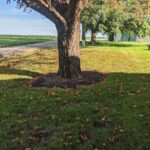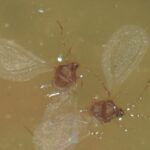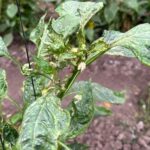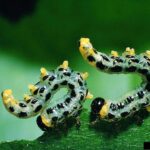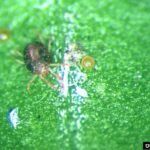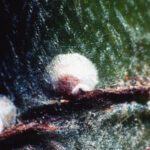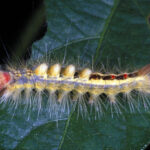Fall has arrived! The beautiful foliage that we love to admire this time of year will soon become the yearly chore of managing fallen leaves. You have likely heard the adage “leave the leaves” many times by now. This practice is gaining traction along with many other pollinator-friendly landscape management tactics, such as saving dead[Read More…]
Christmas tree growers have been struggling with an invasive scale pest called Cryptomeria scale (Aspidiotus cryptomeriae), which is a serious pest of conifers. The scales infest the undersides of the needles and extract plant juices with their piercing-sucking mouthparts. Economic losses are due to the unsightly yellow discoloration and needle drop that occurs from the[Read More…]
Nursery growers and landscapers should stay vigilant for an invasive thrips that is moving across the USA. Thrips parvispinus was first detected in Florida in 2020. It has since spread through Georgia and the Carolinas, and has been detected in Colorado, Ohio, Pennsylvania, and Delaware. It is not known to occur in Indiana, but growers[Read More…]
Sawflies are frequent pests in the landscape that attack a wide variety of plants, from ornamental flowers to large trees. You might start to see them damaging plants around this time of year as the first generations hatch and begin to feed on foliage. They are often mistaken for caterpillars, which are the larval stages[Read More…]
The bitter winter cold has finally passed us (or has it? It’s hard to tell in the Midwest)! The days are getting warmer and longer, and that means the insects are coming out of their overwintering stages. As you prepare for your landscaping and gardening this year, are you implementing preventative measures for pests? Now[Read More…]
Recently, white prunicola scales (Pseudaulacaspis prunicola) were detected on Prunus during a DNR nursery inspection. This is a significant scale pest of woody ornamentals and fruit trees in eastern states, but it is currently not established in Indiana. It is primarily a pest of cherry, lilac, and privet species. Its total reported host range spans[Read More…]
Milkweed is a popular choice in urban landscapes as more citizens engage with monarch conservation efforts and strive to maintain pollinator-friendly landscapes. This past month I have seen numerous images of aphids found on milkweed plants from all over the state. Homeowners are concerned that the infestation will negatively affect the monarch butterflies that rely[Read More…]
Recently a homeowner in Hamilton County posted on the Indiana Native Plant Society Facebook page with concerns about aphids, mites, and apple scab in her maple and oak trees. She asked for a second opinion and treatment options for these pests. I reached out to the homeowner and requested permission to collect samples from the[Read More…]
Blight, Leafminers, and Moths: The Plight of Boxwoods Boxwoods (Buxus spp.) were introduced into the United States during colonial times, and still today they are one of the most popular evergreen shrubs used in landscapes. They are frequently selected for hedges and topiaries because they are easily trimmed into geometric shapes. They were also easy[Read More…]
Hoosiers are in for a special treat this spring. If you have lived in Indiana for more than a year, you have probably grown accustomed to the singing of cicadas in the later days of summer. However, in some years, cicadas will emerge in the spring. This occurred in 2021 when most of the state[Read More…]
Black vine weevil (Otiorhynchus sulcatus) is a serious pest of several ornamental and fruit plants, such as azalea, Cyclamen, caneberries, yew, rhododendron, grape, and strawberry. It is not a widespread issue, but when they occur, infestations can be devastating to a grower. A few larvae can be lethal to a Rhododendron, and the foliage feeding[Read More…]
It’s that time of year when we remind everyone to watch for spotted lanternfly (SLF) infestations. Spotted lanternfly is an invasive insect first detected in Pennsylvania in 2014, and has since spread throughout the eastern USA. Its preferred host is the invasive Tree-of-Heaven, but it also feeds on a wide range of important plant species,[Read More…]
The hemlock woolly adelgid (Adelges tsugae) continues its eastward spread across the US. In 2022, seven new counties were added to the distribution map of this invasive insect. While it is not present in Indiana yet, it is confirmed throughout the eastern USA from northern Georgia to Maine, extending west into Michigan, Ohio, and Kentucky.[Read More…]
The problem There is another invasive species close to Indiana that landscaping and nursery professionals should look for. Box tree moth (Cydalima perspectalis) is native to East Asia, and was first detected in 2021 in New York. Detections in Michigan in 2022 have resulted in a quarantine zone for boxwoods (Buxus spp.) in the state.[Read More…]
If you spend any time reading about native landscapes, you will quickly find numerous articles and guides for plants that are good for pollinators. Many native pollinator species are in decline, and choosing plants that support their lifecycle is a great way homeowners and landscapers can engage with the effort to improve their populations. However,[Read More…]

